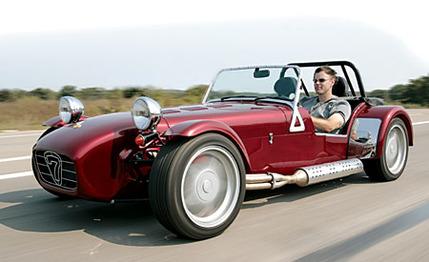
 Specialty File
Specialty File
Those over 5 feet 10 will no longer have to slather on the Crisco to squeeze into the Caterham 7 sports car. The company has introduced a lengthened and broadened version, the Roadsport SV.
No one is happier about this than yours truly, who has long been a fan of Caterhams—and even talked the staff into helping build a Classic ("We Build a Kit Car. Again," April 1998). We spent about a week slapping it together, but elation at the end of assembly turned to real disappointment when it was clear this writer could barely wedge his long-legged, six-foot, 185-pound frame into it.
The founder of Lotus, the late Colin Chapman, designed the predecessor to the Caterham—the Lotus 7—back in the 1950s. Chapman was a pound pincher of the highest order, and his cars were light, small, fast, and oftentimes brittle.
In 1973, 16 years after the Lotus 7 first appeared, the firm halted production and sold the 7 production licenses and tooling to an English car dealer named Caterham. Since then, Caterham has slowly tweaked and updated the car, but until the SV model, Caterham's version, the Classic, retained the original Lotus dimensions.
The Classic is fine if you're anywhere under 5 feet 10. But according to the National Center for Health Statistics, the average height of the American male is 5 foot 9, and there are more than 20 million who are taller. (Sorry, ladies, but you and we know that almost all Caterham buyers are men.)
The SV's wheelbase was stretched by 3.2 inches, and the frame is 4.3 inches wider. Length is up 3.2 inches, to 136.2, because the nose cone was reshaped to retain the original car's proportions. It's still almost 20 inches shorter than a Mazda Miata and is just 44 inches high.
Those few inches make a huge difference in the cockpit. We had legroom to spare, and the new bucket seats have just the right shape, seatback angle, and padding to be perfectly comfortable. Plus, Caterham widened the pedal box. There still isn't a dead pedal, but you can now drive while wearing sneakers, an impossible feat in the smaller car.
Like the Classic, the SV comes as a kit. The $28,595 price includes everything but the engine and transmission. Caterham offers several bolt-in powertrain options. The least expensive is the $4650 100-hp four-cylinder Ford, based on the Cortina, and five-speed Ford transmission.
That's an older carbureted engine, and it's also available with 150 horsepower for $6250. Our test car came with Caterham's latest engine option: Ford's fuel-injected Zetec four-banger.
With the same five-speed tranny, the 147-hp Zetec goes for $7250. (The 170-hp SVT version of the Zetec should be available sometime this winter.) Although the Zetec offers less bang for your buck, it does include exhaust-catalyst and fuel-vapor-recovery systems. Your engine choice may depend on your state's vehicle laws, so some research is in order.
Our car also had a $1300 paint job, and we figured in another $2500 to cover assembly costs. The tally was $39,645, a tricky price to justify when the more practical Honda S2000 and Nissan 350Z roadsters cost less.
But the SV is quicker. With the little motorized skateboard weighing only 1438 pounds, it leaps to 60 mph in 4.6 seconds (versus the S2000 at 5.4 and the Nissan at 5.5). And it hangs onto the skidpad with an impressive 0.96 g of grip (S2000, 0.92; 350Z, 0.88).